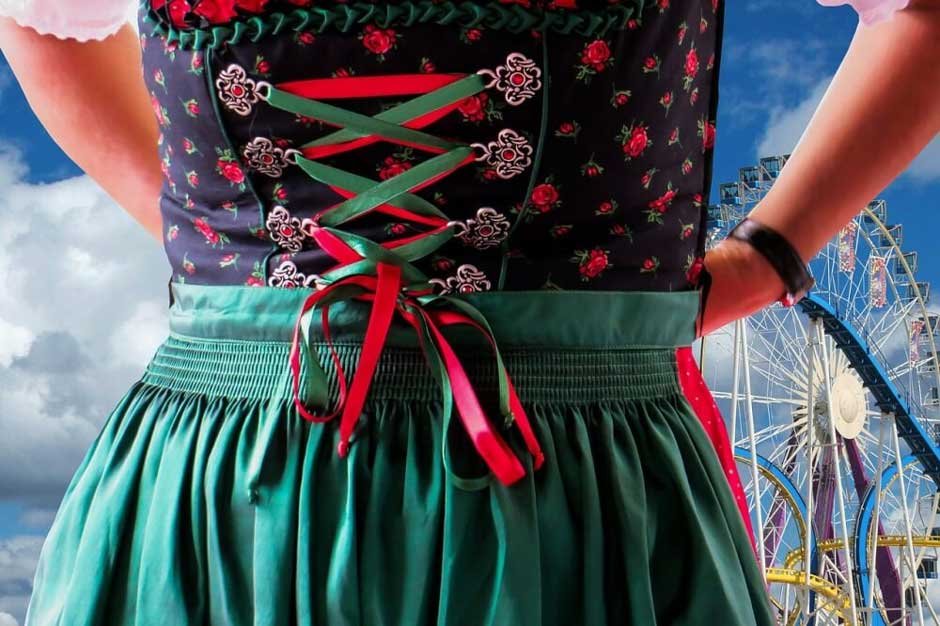Skip to the good bit
ToggleGetting ready to wear a dirndl for the first time or looking to refresh your understanding of this traditional Bavarian attire? The Dirndl is more than just a pretty dress–it is a carefully crafted outfit with key elements that each play an important role in enhancing its beauty. This Bavarian dress, known for its vibrant colors and classic styles, consists of a breathable blouse, stylish bodice, playful skirt patterns, and an apron that adds a sophisticated touch.
Dirndl’s traditional craftsmanship and modern additions with authenticity cater to every taste, from elegant bridal styles to casual beer garden looks. Its versatility has gained popularity globally, especially during the Oktoberfest celebrations, where it represents the cultural heritage of Bavaria.
Anatomy of a Dirndl: The Key Elements of Bavarian Elegance
The dirndl dress is a traditional attire of Alpine regions made of several distinctive components. It is unique and stylish and can be worn on various occasions. This enchanting garment, with its timeless elegance and authenticity in the craftsmanship of its main features like tight bodice and full-length skirt, always captivates the fashion and cultural enthusiast.
Complementary Blouse:
The Dirndl blouse is a versatile piece that allows you to create a harmonious, stylish outfit that expresses your individual personality. This essential component of the traditional Bavarian and Austrian outfit comes in a wide variety of colors, materials, and designs that complement your dirndl while emphasizing the decollete.
The blouse is an underworn clothing piece mainly made of breathable cotton or linen, so it feels soft against the body. It features a range of necklines, such as sweetheart, high-necked stand-up, and scoop neck, each designed to flatter the figure and enhance femininity.
Crafted with traditional material like embroidery or lace for intricate detailing or ruffles and frills at the short puff sleeves for a modern touch, the blouse in white, black, or brighter shades offers every style and design to match your dirndl perfectly. C
Figure-Flattering Bodice:
In German Mieder or Leiberl, the bodice of the dirndl is designed to flatter a woman’s figure. It typically features low, eye-catching necklines that can be round, rectangular, or even deep v-shaped, perfectly complementing the blouse and creating a figure-flattering look.
The bodice is cut to fit tightly to the body with darts at the front, emphasizing the bust and waist to create a classic silhouette. It is constructed as a single piece with a central seam at the front, secured by various closures such as laces, buttons, hooks, or zippers, adding a charm to the overall aesthetic of the German dirndl dress by influencing the outfit’s look.
The bodice is traditionally made from durable fabrics like heavy cotton, but the modern dirndls may incorporate materials such as linen, velvet, or silk, adorned with colorful patterns and intricate designs that enhance the individual personality while offering visual interest.
Tip: A bodice with a deeply cut neckline paired with a matching blouse can create a more reveling and festive appearance, while a high-necked bodice offers a more modest style.
Feminine-Style Dirndl Skirt:
The skirt is the main component of women’s traditional Bavarian dirndl outfits. It has a full, gathered shape at the waist with various length versions, creating both voluminous flair and feminine style in the dress. Originally separate from the bodice, modern dirndl skirts are often sewn together in complementary colors and material options. Its fabric choice varies with the event, as every day is made from more suitable cotton, while the festive versions are crafted with luxurious silk, blended fabrics, or premium velvet adorned with intricate patterns and embellishments.
The dirndl skirt is traditionally midi length and just falls below the knees, but contemporary interpretations may feature longer or shorter cuts with hidden pockets to combine practicality with the updated design.
To connect with roots, floral prints, checks, and solid colors are often used for celebrations like Oktoberfest, often complemented by contrasting aprons.
Decorative Dirndl Apron:
Typically single-colored and simple in design, reflecting local customs and traditions. The dirndl apron was used to protect the dress from dirt and stains. It is now mainly decorative, adding a charming touch to the ensemble. Modern aprons feature more elaborate patterns and designs, incorporating vibrant colors and adorning elements like flower tendrils and check prints with premium threadwork.
The dirndl apron is the most visible part of the outfit and is integral to elevating its unique appeal. Its contemporary versions utilize a variety of materials that can be mixed and matched with different skirts and bodices, enabling wearers to express their personal style.
The apron should be slightly shorter than the dirndl skirt, ending about 2-3 cm above the hem. To ensure it fits snugly at the waist just above the skirt’s seam, a hook-and-eye or button closure is added to its stitching. For a visually striking effect in the outfit, a large bow signifies the wearer’s marital status, and is tied at the apron’s waist.
- Bow tied on the left– Single
- Bow tied on the right— Married
- Bow tied in the center— Virgin
- Bow tied in the middle back— Widow or child.
The bow should be large and prominent ribbons that pair well with the color of your Oktoberfest outfit, and drape down on the apron to give your look a more finishing touch.
Dirndl Craftsmanship: The Art of Creating Authentic Bavarian Attire
Your dirndl should reflect a rich tradition of textile art and design that has evolved over centuries. It is traditional attire in which each seam showcases meticulous craftsmanship and artisan skills. With a variety of fabric options, ranging from soft cotton and linen to silk, organza, or velvet, the choice of material used in crafting dirndls influences the dress’s comfort and appearance.
The authentic dirndl is known for its hand-embossed traditional embroidery patterns with regional motifs and personal touches, but modern artisans also employ digitally crafted designs or fabrication while preserving the garment’s cultural identity.
Its authenticity and quality can be seen in its traditional sewing methods, which ensure precise pattern cutting and assembly for a perfect fit. The dirndl dress, in which handcrafted buttons, hemming, trimmings, and finishing are more focused while crafting each component, provides a more polished yet classic look to its wearer.
Accessorizing and Styling: Enhancing the Dirndl’s Charm
Putting on a dirndl is a way to connect to previous generations of Bavarian women who wore similar dresses. It bridges the gap between the present and cultural legacy. However, unlike in the past when it was worn as a simple dress, these days, women style the dirndl for festivities and events with traditional or modern accessories while preserving its original charm and for a delightful experience.
- Pair it with Bavarian jewelry, such as a Charivari chain, beer stein earrings, or understated necklaces, which maintain authenticity.
- When it comes to footwear, classic options like Mary Janes or simple flats work best, with a great focus on dress aesthetics.
- Opt for a simple hairstyle—thick braids or a delicate headband— to enhance your look without being too casual.
- Add a petticoat if you desire more fantasy flair in your skirt.
While accessorizing, ensuring that every element compliments others without overpowering the dirndl with modern or flashy additions is essential.
Choosing the Right Dirndl: Tips for Every Occasion
When selecting a dirndl, consider style, occasion, and personal comfort. It is available in a range of options, from traditional to contemporary designs, and can be worn at weddings, cultural events, and formal gatherings. But your selection matters, like for Oktoberfest, a more traditional dirndl in classic colors and patterns may be appropriate. If you are donning it for a wedding, then choose the shimmery and luxurious maxi-length dirndl with premium detailing in more sparkling shades.
Conclusion:
Understanding the essentials of a dirndl not only enhances appreciation for this attire but also aids in selecting the perfect Oktoberfest outfit for various events. The dirndl’s skillfully crafted components, according to the latest trends, when paired with modern accessories and styling methods, allow you to embrace traditional Bavarian attire gracefully and stand out in the crowd.







